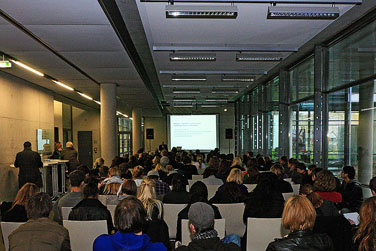Symposium 2009: Material and profession – all that can be done!
(mk) New methods of production, new construction tasks, new materials or old materials in a new function – new opportunities for creativity are constantly being created in order to go beyond the supposed borders of design and technology. This was also the topic of this year's symposium at the Departments of Architecture and Design in the foyer of the extension building on 5th November 2009. As ever more young architects, interior architects and designers are feeling the need to seek out niches in professional fields which do not belong to the classic disciplines due to the tense situation on the job market, the faculties have reacted accordingly: The symposium entitled "New Materials" gave the students the chance to gain an insight into new professional fields and to get ideas for their own practice.
And the positive response to the symposium proved the organisers right: Moderator Edgar Haupt welcomed well over eighty students and interested visitors in the completely filled foyer. After the president of the University, Prof. Dr. Brigitte Grass, had greeted the guests, the deans of the design faculties also made use of the occasion to put forward hypotheses on the subject of "material" from the perspective of their different disciplines. Prof. Dierk van den Hövel, dean of the Department of Architecture, talked about material and profession in new contexts, whilst the dean of the Department of Design, Prof. Dr. Stefan Asmus, offered thoughts on the term material in digital contexts.
A particular highlight was the subsequent presentation made by student Sunanta Srisook, who received recognition for her research work in 2009 from ARCH+, a magazine for architecture and culture, as part of its "Simple systems – complex capacities" competition. Sunanta has worked extensively with loam. She has further developed the functionality of this as a building material by structural differentiation. In fact loam is one of the oldest building materials known to mankind and is still used to construct 50 % of all buildings in the so-called Third World, thus making up a good third of structures around the globe. Loam's few drawbacks, such as the fact that it is not water-tight and is relatively laborious to process, are outweighed by a series of clear benefits compared to other construction materials: It can be formed into any shape, it stores heat and regulates air humidity, it is a low energy and cost saving material and requires only a minimum amount of equipment. The student was thus able to mix a base mass by ecological means consisting of loam, sand and water in her own "kitchen laboratory", in which yeast bacteria then contributed to pore formation. After being allowed to dry, the compressive strength of the foamed loam was equal to that of simple burnt bricks, whilst its raw density was even lighter. The foam structure furthermore provided improved thermal insulation. Although the foamed loam is not (yet) able to bear static loads, Sunanta Srisook is sure that it can still be used: "Loam could be produced on an industrial scale, like concrete. It's possible to imagine using it to construct room separators, say, or as an acoustic and thermal insulating material", says the hard-working student, who is already planning further marketing opportunities after the development work.
